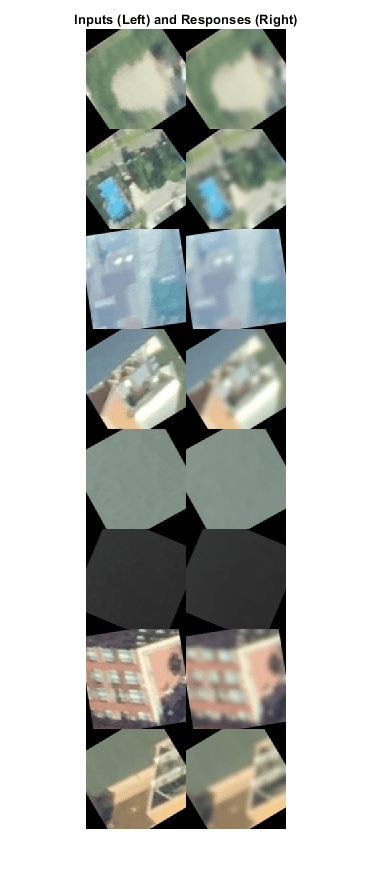randomPatchExtractionDatastore
Datastore for extracting random 2-D or 3-D random patches from images or pixel label images
Description
A randomPatchExtractionDatastore object extracts corresponding
randomly-positioned patches from two image-based datastores. For example, the input datastores
can be two image datastores that contain the network inputs and desired network responses for
training image-to-image regression networks, or ground truth images and pixel label data for
training semantic segmentation networks.
This object requires that you have Deep Learning Toolbox™.
Note
When you use a randomPatchExtractionDatastore as a source of training
data, the datastore extracts multiple random patches from each image for each epoch, so that
each epoch uses a slightly different data set. The actual number of training patches at each
epoch is the number of training images multiplied by PatchesPerImage. The image patches are not stored in memory.
Creation
Syntax
Description
patchds = randomPatchExtractionDatastore(
uses name-value arguments to set the ds1,ds2,PatchSize,Name,Value)PatchesPerImage, DataAugmentation, and DispatchInBackground properties. You can specify multiple
name-value arguments.
For example,
randomPatchExtractionDatastore(imds1,imds2,50,"PatchesPerImage",40)
creates a datastore that randomly generates 40 patches of size 50-by-50 pixels from each
image in image datastores imds1 and imds2.
Input Arguments
Properties
Object Functions
combine | Combine data from multiple datastores |
hasdata | Determine if data is available to read |
numpartitions | Number of datastore partitions |
partition | Partition a datastore |
partitionByIndex | Partition randomPatchExtractionDatastore according to
indices |
preview | Preview subset of data in datastore |
read | Read data from randomPatchExtractionDatastore |
readall | Read all data in datastore |
readByIndex | Read data specified by index from
randomPatchExtractionDatastore |
reset | Reset datastore to initial state |
shuffle | Shuffle data in datastore |
transform | Transform datastore |
isPartitionable | Determine whether datastore is partitionable |
isShuffleable | Determine whether datastore is shuffleable |
Examples
Tips
The
randomPatchExtractionDatastoreexpects that the output from thereadoperation on the input datastores return arrays of the same size.If the input datastore is an
ImageDatastore, then the values in itsLabelsproperty are ignored by therandomPatchExtractionDatastore.To visualize 2-D data in a
randomPatchExtractionDatastore, you can use thepreviewfunction, which returns a subset of data in a table. Visualize all of the patches in the same figure by using themontagefunction. For example, this code displays a preview of image patches from arandomPatchExtractionDatastorecalledpatchds.minibatch = preview(patchds); montage(minibatch.InputImage)
Version History
Introduced in R2018b
See Also
augmentedImageDatastore (Deep Learning Toolbox) | pixelLabelDatastore (Computer Vision Toolbox) | imageDatastore | trainnet (Deep Learning Toolbox) | imageDataAugmenter (Deep Learning Toolbox) | TransformedDatastore
Topics
- Increase Image Resolution Using Deep Learning
- JPEG Image Deblocking Using Deep Learning
- Image Processing Operator Approximation Using Deep Learning
- Semantic Segmentation of Multispectral Images Using Deep Learning
- Datastores for Deep Learning (Deep Learning Toolbox)
- Preprocess Images for Deep Learning (Deep Learning Toolbox)
- Deep Learning in MATLAB (Deep Learning Toolbox)
